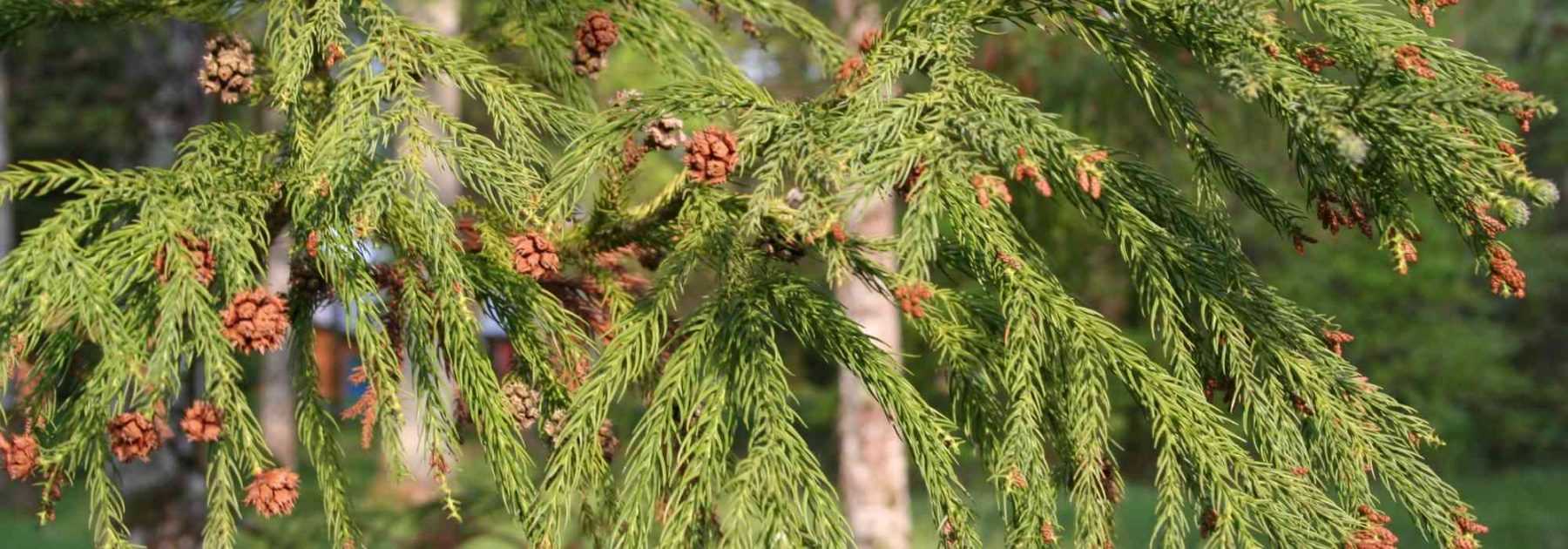
Cryptomeria, Japanese Cedar: Planting, Pruning and Care
Contents
The Japanese Cedar or Sugi, in a few words
- Japanese Cryptomerias are conifers with a very straight trunk and short, curved needles that bend towards the branch without being prickly, giving them a reptilian appearance.
- Used as timber wood in Japan or on Réunion Island, it is grown in gardens for the ornamental qualities of its many sought-after cultivars.
- You can find dwarf forms like Cryptomeria japonica Vilmoriniana, moderately vigorous varieties like Sekkan Sugi with cream-coloured shoots, or Elegans, distinguished by its very elegant feathery foliage that turns rust-coloured in autumn.
- Cryptomerias are hardy trees (-15 to -20°C) that thrive in deep, cool, rich but well-drained soil and can be planted as standalone specimens or in sunny or partially shaded rock gardens.
Our expert's word
Japanese Cedar (Cryptomeria japonica), known as sugi in Japanese, is a large conifer native to Japan, China and Korea that is truly unique in its genus. There is only one species of Cryptomeria with some morphological variations depending on its origin, but it has given rise to many less vigorous, even dwarf cultivars that are highly sought after in gardens. This conifer with an elegant pyramidal habit, clad in fine evergreen foliage and easy to grow, is a must-have in any collector’s garden. Its considerable, if not gigantic, development reaching nearly 40 m in its natural habitat is reduced to around ten metres in Europe, although there are some specimens of 30 m in England. Nevertheless, it is the countless cultivars of more modest stature, such as the Japanese Cedar Elegans Viridis, or even dwarf forms like ‘Elegans Nana’, that are most common in private gardens. These conifers are selected to form beautiful evergreen hedges that offer magnificent rust, bronze or red colours in autumn and winter, or unusual specimens to display as standalone features, such as Cryptomeria japonica Sekkan Sugi or Cryptomeria japonica Vilmorin Gold for example.
Japan’s national tree, the Cryptomeria was introduced to Europe in the mid-19th century and is a first-order forest species in Japan, China, the Azores and Réunion Island where it was introduced. Its fragrant and rot-resistant wood is reputed to deter insects and termites. An essential oil with a woody scent is extracted from it, valued for purifying the air in our homes.
The growth of Cryptomeria is rather rapid (except for dwarf forms), and its smaller varieties prove to be undemanding when it comes to soil, though they prefer rich, moist and well-drained, slightly acidic ground to thrive. It is recommended to plant it in a sheltered position. Container planting is possible for dwarf varieties, with the size of the container influencing the size of the young plant: young cryptomerias are indeed excellent choices for bonsai enthusiasts!
Description and Botany
Botanical data
- Latin name Cryptomeria
- Family Taxodiaceae
- Common name Japanese Cedar, Sugi
- Flowering February to March
- Height 0.30 to 40 m
- Exposure sun or partial shade
- Soil type moist, clay, acidic to neutral
- Hardiness Good (-15 to -20°C)
The Cryptomeria japonica (syn. fortunei) belongs to the Taxodiaceae family, like the Bald Cypress (Taxodium distichum), the American Sequoias or the Chinese Metasequoia, but its leaves resemble no other conifer. They consist of pointed but not sharp claws, 1 cm long, arranged awl-like around the branchlet, whose smooth and rather flexible texture resembles plastic. The evergreen leaves eventually renew after a few years but in a peculiar way, as entire branchlet sections turn brown before falling, a phenomenon called decuritation, also observed in Araucaria.
The Japanese Cedar reaches impressive dimensions up to 30-55 m in height, with a very slender habit and rapid growth of about 6 to 8 m in 10 years in Japan’s rainforests. Its longevity may reach 1000 to 2000 years according to a specimen at Misaka Shrine in Nagano, standing 30 m tall with a trunk 4 m in diameter at the base. Its reddish-brown bark peels in vertical strips. Its distribution area in the warm mountainous regions of Japan and southern China between 1000 and 2500 m altitude demonstrates its great adaptability, especially as this species existed during the time of dinosaurs. There is some variability between Japanese and Chinese specimens. Cryptomeria japonica var. sinensis has a less rigid habit due to finer branchlets. Moreover, Japanese researchers found that above 1750 m, Cryptomeria propagates solely by layering, while more favourable conditions also allow sowing, leading to greater genetic diversity.
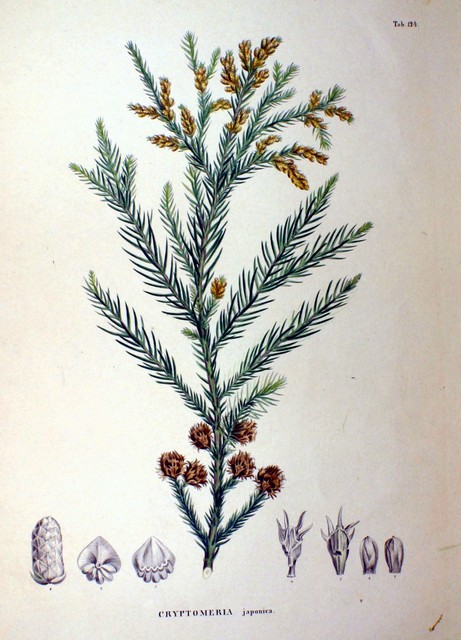
Cryptomeria japonica – botanical illustration
The species has given rise to over two hundred cultivars, including compact dwarf forms with very slow growth and extremely short needles like Vilmoriniana, or forms with soft, airy foliage like Elegans or Elegans Viridis. The leafy branchlets of cultivars often take on an exceptional reddish-bronze to rusty colour in cold weather, particularly in the Elegans cultivar, whose columnar habit reaches up to 9 m tall and 2.40 m wide, or even more when it begins layering and forms a grove! The variety Cryptomeria japonica var. cristata produces fused, flattened shoots resembling a cockscomb, adding an incongruous note to the scene.
Flowering is monoecious; the male aments form small terminal clusters in winter, releasing abundant pollen in February-early March. The female flowers form tiny green rosettes at the tips of branchlets, which swell after fertilization to reach 1.5 cm in diameter by autumn before browning and releasing their seeds the following autumn. Each cone has about forty scales ending in a recurved point.
The Japanese Cedar is widely used as an ornamental plant in temperate gardens worldwide, in Europe, India, North America, and Australia, while it serves as an important forest tree in Japan, China, the Azores, and Réunion. It is also deeply revered in Japan, particularly in Nikko near Tokyo, where a row of nearly 14,000 specimens, aged four centuries, lines a 37 km avenue. Its highly fragrant but rather soft wood is prized for temple construction and coffins in China, and is also used in furniture, building, and panelling as it resists fungal and insect attacks well, likely due to its essential oil content.
Read also
How to Take Cuttings from Conifers?The main varieties of Cryptomeria
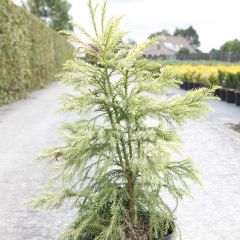
Cryptomeria japonica Sekkan-Sugi
- Height at maturity 6,50 m
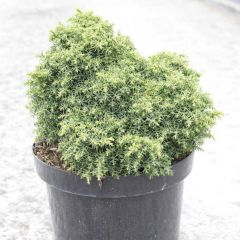
Cryptomeria japonica Yokohama
- Height at maturity 1,10 m
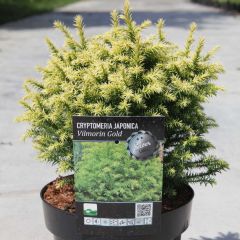
Cryptomeria japonica Vilmorin Gold
- Height at maturity 1 m
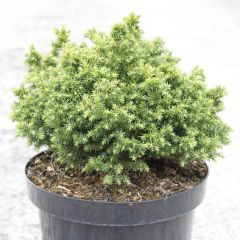
Cryptomeria japonica Vilmoriniana
- Height at maturity 90 cm
Discover other Cryptomeria
View all →Available in 1 sizes
Available in 2 sizes
Available in 1 sizes
Available in 1 sizes
Available in 2 sizes
Available in 2 sizes
Available in 2 sizes
Available in 1 sizes
Available in 1 sizes
Available in 1 sizes
Planting
Where to plant Cryptomeria?
Cryptomeria thrives in ordinary, fairly moist, well-drained, rather fertile soil, even slightly chalky, neutral or acidic. It dislikes excessively dry or shallow soils. It particularly enjoys the mild and humid climate of the Atlantic coast but adapts fairly easily elsewhere, though its dimensions remain more modest.
Plant it in full sun if the climate allows, except for cultivars with light foliage like Sekkan Sugi, which fare better in partial shade to avoid sun scorch. Position the young plant sheltered from dry, cold winds, which can scorch young shoots, and in partial shade in southern regions. Minimum temperatures range from -15°C to -20°C depending on the clone, though branches struggle under heavy snow.
Dwarf forms tolerate planting in deep containers, which slows their growth and helps maintain a more compact habit. They also suit rockeries, provided they’re not too sunny or windy, as the plant seeks atmospheric moisture. The roots can draw humidity from beneath rocks. Bonsai cultivation is common with Cryptomeria.
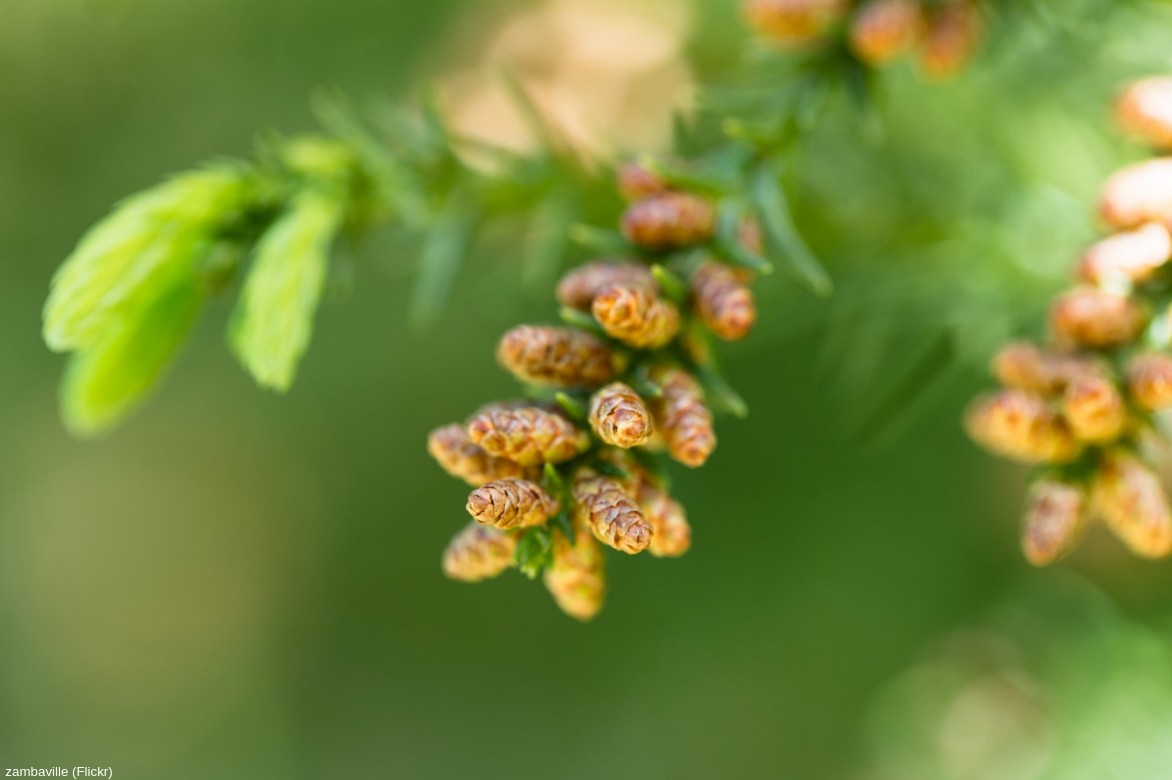
Male aments of Cryptomeria japonica
When to plant?
Cryptomeria japonica is best planted from September to November and February to June. In mild, well-watered climates, pot-grown specimens can be planted almost year-round, avoiding extreme cold or heat.
How to plant?
With smaller young plants (50cm tall), such as 2-year-olds, establishment is very easy.
- Soak the pot in a bucket of water to moisten thoroughly.
- Dig a hole 3 times wider than the rootball and aerate the surrounding soil with a fork.
- Add manure or compost to ensure strong early growth, as the tree can grow quite quickly.
- Place the plant in the planting hole.
- Backfill and firm gently, creating a shallow basin.
- Mulch to retain moisture and water with at least 10 litres.
For deep, large containers, add a drainage layer (gravel, clay pebbles, crocks…), then a mix of 1/3 garden soil, 1/3 sand and 1/3 heather soil, turf or well-rotted compost. Mulch the pot surface.
Maintenance
- Water the Cryptomeria generously during the first 3-4 years, and during prolonged dry spells. The young plant becomes fairly self-sufficient quite quickly unless grown in a container. Remember to mist the water regularly on specimens trained as bonsai.
- Apply a specialist conifer fertiliser every year in April and hoe the soil in summer to prevent capillary rise if you don’t have mulch.
- You can leave fallen dry twigs on the ground to form a natural mulch.
- Protect young plants with winter fleece if winters are cold.
- Pruning is not necessary. Dwarf forms may undergo light pruning of branches in March-April or late summer (August-September), just like Cryptomeria japonica ‘Elegans’ which dislikes hard pruning!
- There are no reported diseases or pests affecting Cryptomeria in Europe. Honey fungus (Armillaria) has been reported in some countries like Hawaii under warm, humid conditions.
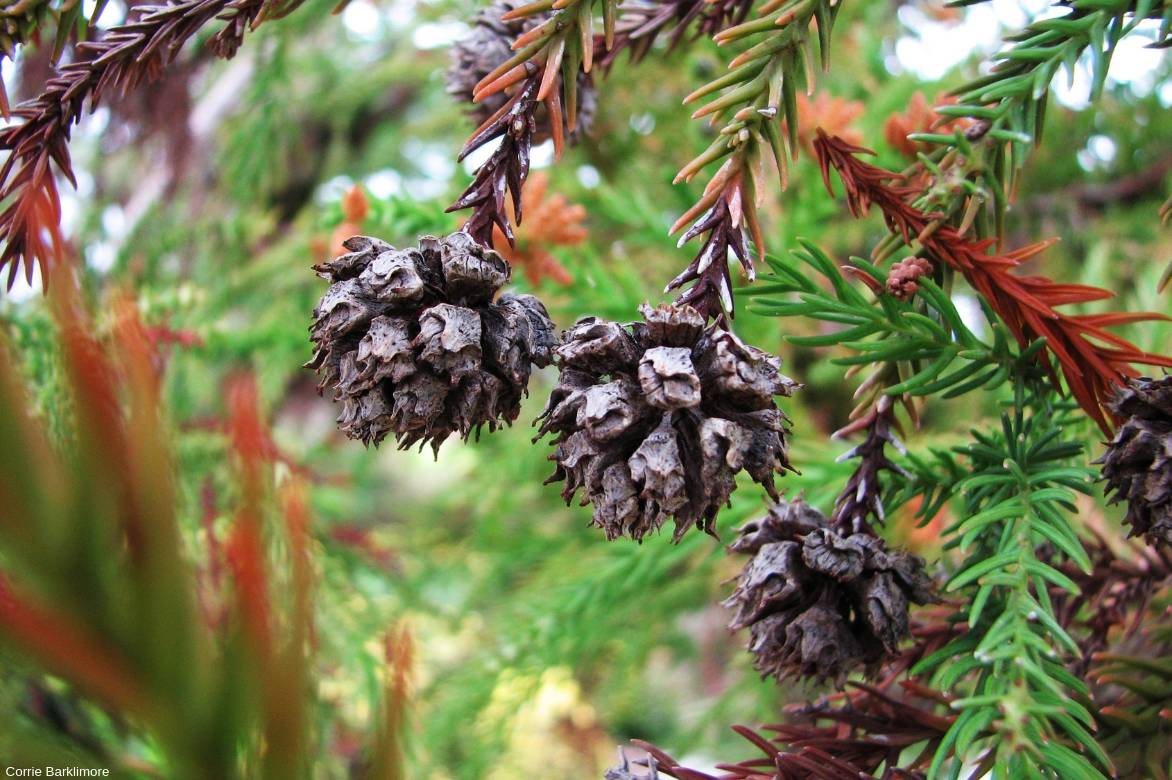
Cones of Cryptomeria japonica
Propagation
The simplest method of propagation involves taking cuttings from Cryptomeria and its cultivars between August and October or sowing seeds of the species type in spring.
Propagation by cuttings
Prepare a deep pot by filling it with 50% turf and 50% sand.
- Take 15 cm long semi-hardwood cuttings from the most vigorous shoot tips.
- Remove the needles from the base of the cutting.
- Dip the base in plant hormone for cuttings.
- Insert them two-thirds of their length into the soil, ensuring they do not touch each other.
- Gently firm the soil around them to eliminate air pockets and ensure good contact between the compost and the cutting.
- Place them in a humid, shaded environment, for example by covering them with a transparent plastic bottle cut in half.
- Remove the plastic after a month and keep your cuttings warm, protected from direct sunlight.
- Wait 4 to 6 months for sufficient root development.→ Discover our tutorial: How to propagate conifers from cuttings?
Sowing
- Obtain seeds from a reputable seed supplier.
- Stratify them for a few days in the refrigerator.
- Sow them in a tray filled with compost mixed with sand.
Uses and Combinations
The varieties of Cryptomeria have often been selected for the seasonal colour variations they offer, starting with a very bright green in spring that darkens in summer before turning reddish, sometimes even taking on fiery hues with the cold, as seen in Vilmorinia or Elegans. Their ball-shaped forms in Compressa, conical in Yokohama, decidedly weeping in Sekkan Sugi, and columnar in Elegans provide a range of possibilities for pairing with other low-growing evergreen bushes or for creating a hedge. Don’t hesitate to plant them alongside bushes with small, glossy, richly coloured leaves such as Abelia Sparkling Silver, Berberis darwinii or thunbergii Orange Dream or Golden Carpet. Heathers and other dwarf conifers with bluish tones like Juniperus squamata Blue Star are among the many options for accompanying Cryptomeria in a rockery or on a terrace. This plant, with its unique silhouette and foliage texture, pairs well with large stones, geometric lines, and masonry work.
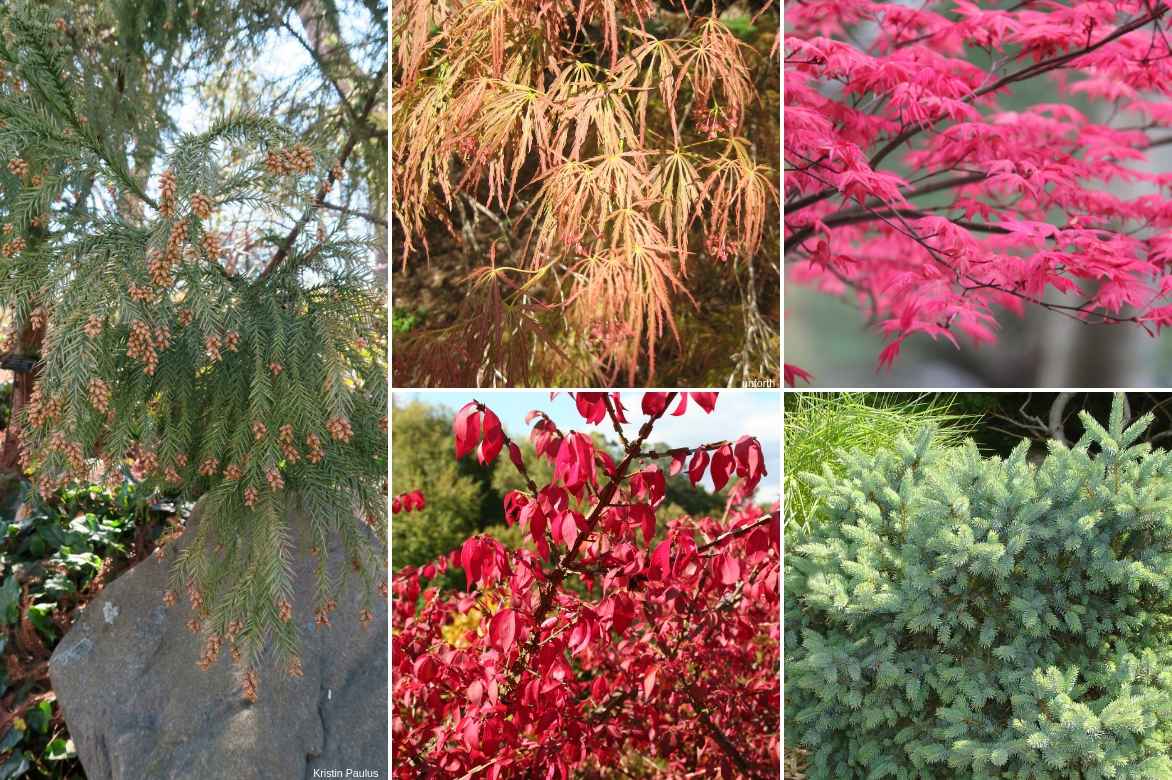

An autumn pairing idea: Cryptomeria japonica ‘Sekkan Sugi’, Acer palmatum ‘Dissectum’, Acer palmatum ‘Shindeshojo’, Euonymus alatus and Picea glauca Cecilia’
Cryptomeria japonica Sekkan Sugi, with its snow-covered fir-like appearance, understated elegance, and moderate growth reaching up to 6.50 m in height and 3.5 m in width, deserves a place in the garden. It can brighten up partially shaded areas or serve as a low-maintenance, luminous backdrop for flower beds, thanks to its cream to almost white foliage in winter. It can thus highlight the flowering of a fragrant wild camellia such as Camellia lutchuensis.
The standard species Cryptomeria japonica, often featuring multiple straight trunks and permanent dark green, reptilian-like foliage, is a remarkable choice for an average-sized garden that will make a striking standalone feature, especially as it remains modest in size, reaching around 10 m in height and 3 to 5 m in diameter. Alternatively, pair it with maples, ginkgos, or liquidambars to create a striking autumn contrast.
To go further
Discover our range of Cryptomerias: the most beautiful varieties for all types of gardens
Watch our video about Cryptomeria ‘Sekkan Sugi’
- Subscribe!
- Contents
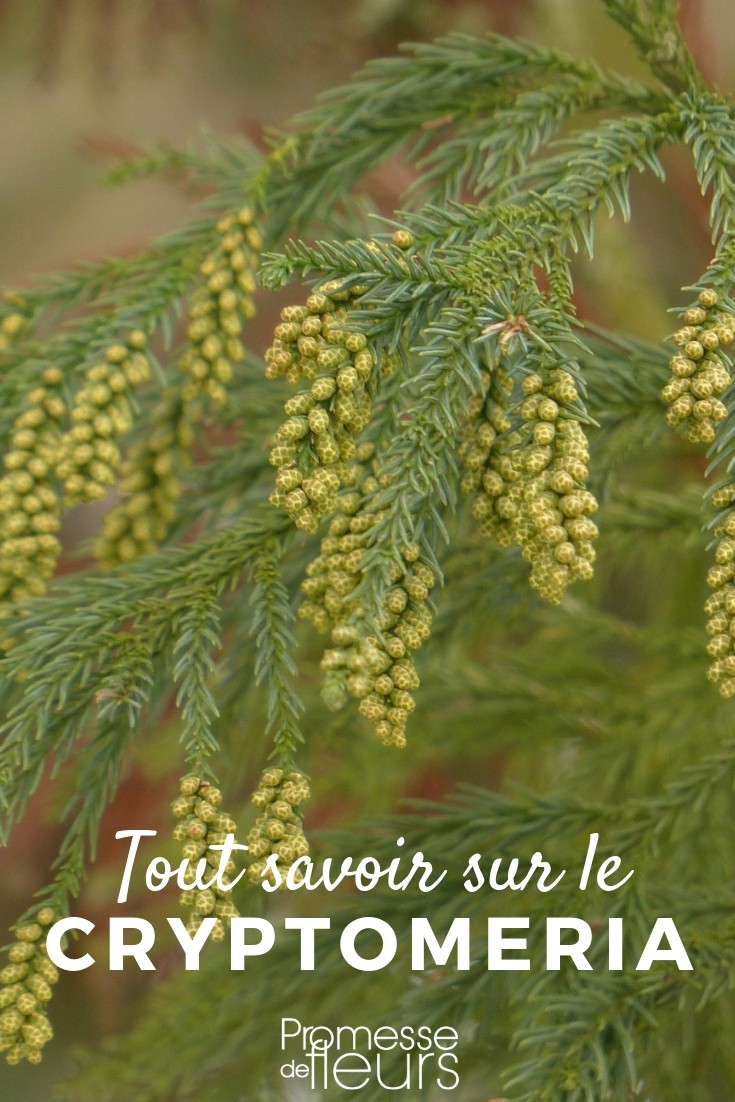


































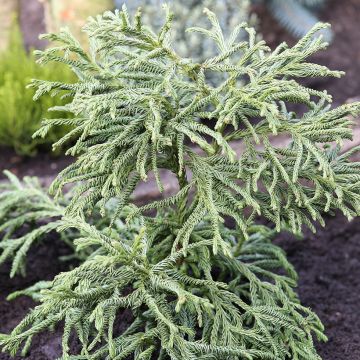
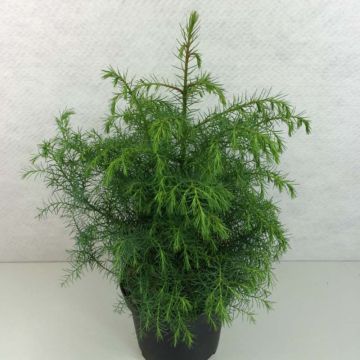
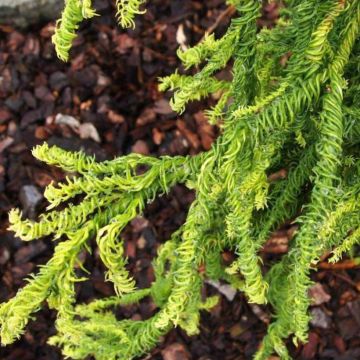
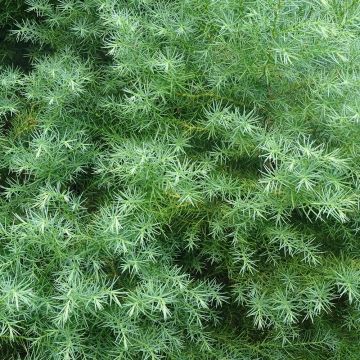



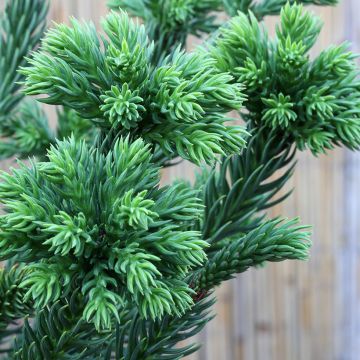

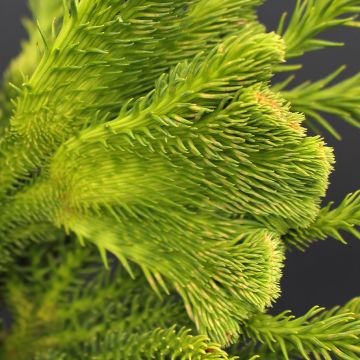
Comments